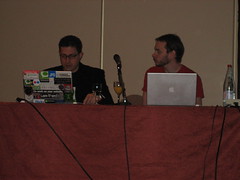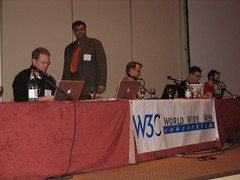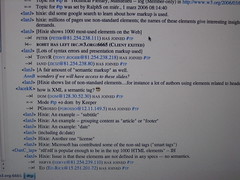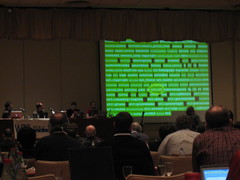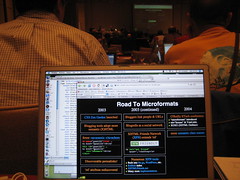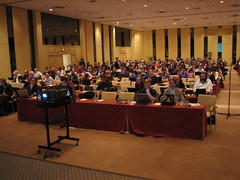events/2006-03-01-w3c-plenary-microformats: Difference between revisions
SitdrOncoa (talk | contribs) (getcaelb) |
|||
| Line 1: | Line 1: | ||
colaorchilac | |||
<h1>Microformats panel at W3C Plenary Day</h1> | <h1>Microformats panel at W3C Plenary Day</h1> | ||
| Line 16: | Line 17: | ||
Description: Leveraging the widespread adoption and understanding of CSS and semantic (X)HTML among web designers and publishers, microformats are a set of simple, practical, open data formats that are designed for humans first and machines second. Microformats are designed by researching and adapting to current human web publishing behaviors and usage patterns, and then reusing bits of existing widely adopted standards. This session will demonstrate the capabilities that have been quickly developed with microformats on today's Web, review current microformats, and open discussion on what microformats and related efforts mean for the future of the Web.. | Description: Leveraging the widespread adoption and understanding of CSS and semantic (X)HTML among web designers and publishers, microformats are a set of simple, practical, open data formats that are designed for humans first and machines second. Microformats are designed by researching and adapting to current human web publishing behaviors and usage patterns, and then reusing bits of existing widely adopted standards. This session will demonstrate the capabilities that have been quickly developed with microformats on today's Web, review current microformats, and open discussion on what microformats and related efforts mean for the future of the Web.. | ||
Moderators: Tantek | Moderators: Tantek Ãelik (Technorati) and Don Connolly (W3C) | ||
Presenters and Topics: | Presenters and Topics: | ||
* Ian Hickson (Google) - "[http://www.w3.org/2006/03/01-Hickson/Semantics.html A billion documents and no semantics anywhere]" | * Ian Hickson (Google) - "[http://www.w3.org/2006/03/01-Hickson/Semantics.html A billion documents and no semantics anywhere]" | ||
* Tantek | * Tantek Ãelik (Technorati) - "[http://tantek.com/presentations/2006/03/what-are-microformats/ What are microformats?]" | ||
* | * HÃ¥kon Wium Lie (Opera) - "Cascading Markup Languages â boom!" | ||
* Rohit Khare (CommerceNet) - "[http://labs.commerce.net/~rohit/Angstro-W3C-TP/ Where Angle Brackets Fear to Tread]" | * Rohit Khare (CommerceNet) - "[http://labs.commerce.net/~rohit/Angstro-W3C-TP/ Where Angle Brackets Fear to Tread]" | ||
* Dan Connolly (W3C) - "[http://www.w3.org/2003/g/talk62/slides Microformats for practical Semantic Web deployment]" | * Dan Connolly (W3C) - "[http://www.w3.org/2003/g/talk62/slides Microformats for practical Semantic Web deployment]" | ||
| Line 48: | Line 49: | ||
=== Tantek | === Tantek Ãelik === | ||
"[http://tantek.com/presentations/2006/03/what-are-microformats/ What are microformats?]" | "[http://tantek.com/presentations/2006/03/what-are-microformats/ What are microformats?]" | ||
| Line 56: | Line 57: | ||
How did we get here? Picking up (hopefully) where the previous talk left off, a brief review of recent web authoring trends, a timeline of the ideas that formed microformats, and demonstrations how hCard and hCalendar are being put to good use today by publishers, browsers, and end users alike. | How did we get here? Picking up (hopefully) where the previous talk left off, a brief review of recent web authoring trends, a timeline of the ideas that formed microformats, and demonstrations how hCard and hCalendar are being put to good use today by publishers, browsers, and end users alike. | ||
=== | === HÃ¥kon Wium Lie === | ||
"Cascading Markup Languages | "Cascading Markup Languages â boom!" | ||
Cascading in CSS allows descigners to not have to provide the full presentation of a | Cascading in CSS allows descigners to not have to provide the full presentation of a | ||
| Line 94: | Line 95: | ||
Alphabetically sorted by last name. | Alphabetically sorted by last name. | ||
* Jonny Axelsson | * Jonny Axelsson | ||
* David Baron | * David Baron | ||
* Tim Berners-Lee | * Tim Berners-Lee | ||
* Bert Bos | * Bert Bos | ||
* Tantek | * Tantek Ãelik | ||
* Dan Connolly | * Dan Connolly | ||
* Ian Hickson | * Ian Hickson | ||
* Rohit Khare | * Rohit Khare | ||
* Kevin Lawver | * Kevin Lawver | ||
* | * HÃ¥kon Wium Lie | ||
* ... | * ... | ||
* ... | * ... | ||
| Line 137: | Line 136: | ||
Taken by: | Taken by: | ||
[http://flickr.com/photos/dbaron/tags/techplen/ David Baron], | [http://flickr.com/photos/dbaron/tags/techplen/ David Baron], | ||
[http://www.flickr.com/photos/tantek/tags/techplen2006/ Tantek | [http://www.flickr.com/photos/tantek/tags/techplen2006/ Tantek Ãelik], | ||
[http://glazman.org/W3C-TP-2006/ Daniel Glazman], | [http://glazman.org/W3C-TP-2006/ Daniel Glazman], | ||
[http://flickr.com/photos/amyvdh/tags/techplen/ Amy van der Hiel], | [http://flickr.com/photos/amyvdh/tags/techplen/ Amy van der Hiel], | ||
Revision as of 02:19, 20 December 2008
colaorchilac
Microformats panel at W3C Plenary Day
One of several microformats events.
During the W3C Plenary Day (has hCard & hCalendar!) in the middle of the W3C All Group Meetings Week in Mandelieu, FRANCE.
Summary
This is the summary of the panel as published at http://www.w3.org/2006/03/01-TechPlenAgenda.html :
Session 3: Microformats
Description: Leveraging the widespread adoption and understanding of CSS and semantic (X)HTML among web designers and publishers, microformats are a set of simple, practical, open data formats that are designed for humans first and machines second. Microformats are designed by researching and adapting to current human web publishing behaviors and usage patterns, and then reusing bits of existing widely adopted standards. This session will demonstrate the capabilities that have been quickly developed with microformats on today's Web, review current microformats, and open discussion on what microformats and related efforts mean for the future of the Web..
Moderators: Tantek Ãelik (Technorati) and Don Connolly (W3C)
Presenters and Topics:
- Ian Hickson (Google) - "A billion documents and no semantics anywhere"
- Tantek Ãelik (Technorati) - "What are microformats?"
- HÃ¥kon Wium Lie (Opera) - "Cascading Markup Languages â boom!"
- Rohit Khare (CommerceNet) - "Where Angle Brackets Fear to Tread"
- Dan Connolly (W3C) - "Microformats for practical Semantic Web deployment"
Session Descriptions
These are session descriptions from each presenter.
Ian Hickson
"A billion documents and no semantics anywhere"
Slides: http://www.w3.org/2006/03/01-Hickson/Semantics.html
The "semantics" in the title refers to the "semantics" given to the Web by HTML, as opposed to the "semantics" that are actually put in the Web by the humans. Microformats can document existing practices (especially based on the data from studies of existing documents) so that the existing content can be given "official" "semantics".
Basically my talk was "ooo look pretty shiny billion documents lots of data that shows people use HTML not like it was intended but we can reverse engineer microformats out of existing practices to obtain useful information".
Tantek Ãelik
Slides: http://tantek.com/presentations/2006/03/what-are-microformats/
How did we get here? Picking up (hopefully) where the previous talk left off, a brief review of recent web authoring trends, a timeline of the ideas that formed microformats, and demonstrations how hCard and hCalendar are being put to good use today by publishers, browsers, and end users alike.
HÃ¥kon Wium Lie
"Cascading Markup Languages â boom!"
Cascading in CSS allows descigners to not have to provide the full presentation of a document, they only need to supply the deltas from the html default style sheet; cascading does the rest. In the same way, microformats builds on the (admittantly shallow) semantics of HTML; you don't have to create a new laguage to describe more semantics, you just provide the deltas on top of HTML.
This is one of the design principles that CSS and microformat share, others inlcude: simplicity, author-friendliness, an evolutionary approach.
Boom will be provided as an example.
Rohit Khare
"Where Angle Brackets Fear to Tread"
Slides: http://labs.commerce.net/~rohit/Angstro-W3C-TP/
XML has been a wild success almost everywhere in the information technology universe *except* for adding semantically-rich information to ordinary Web pages. Once upon a time, we were supposed to wish for <price> elements sprinkled about our HTML -- why is are we supposed to be so much more excited to see class="price" this time around? Dr. Khare will speak about his experiences with both xml and microformats in light of a recent project, hListing (for classified ads), and writing a parser and search engine for microformats in general.
Dan Connolly
"Microformats for practical Semantic Web deployment"
Slides: http://www.w3.org/2003/g/talk62/slides
Microformats provide just enough structure to use semantic web technologies like RDF, OWL, and SPARQL on data in ordinary web pages. Dan will relate a few case studies and demonstrate some tools.
Attending
Please add your name here if you are attending the W3C Plenary Day (whether you are speaking or not). Consider adding yourself to the MeetingTaxis page as well to coordinate rides to/from Nice airport.
Alphabetically sorted by last name.
- Jonny Axelsson
- David Baron
- Tim Berners-Lee
- Bert Bos
- Tantek Ãelik
- Dan Connolly
- Ian Hickson
- Rohit Khare
- Kevin Lawver
- HÃ¥kon Wium Lie
- ...
- ...
Session Comments and Q&A
The meeting was video/audiotaped. Could those who have a copy please transcribe the Q&A and comments it here? Those of us who were there might remember who was each speaker and could then annotate that information as well.
- "I'm very excited about microformats. What I really want is to get all the data out of databases and expressed as part of the Semantic Web." - Tim Berners-Lee. (emphasis added)
- ...
Thanks
Thanks to RobertBachmann for helping markup the W3C Plenary Day page with hCard & hCalendar. Previous working version of the page.
Photos
See also the microformatsw3c tag on Flickr.
Photos from the W3C Technical Plenary Week
Taken by: David Baron, Tantek Ãelik, Daniel Glazman, Amy van der Hiel, Richard Ishida, Libby Miller, Luis Villa del Campo

